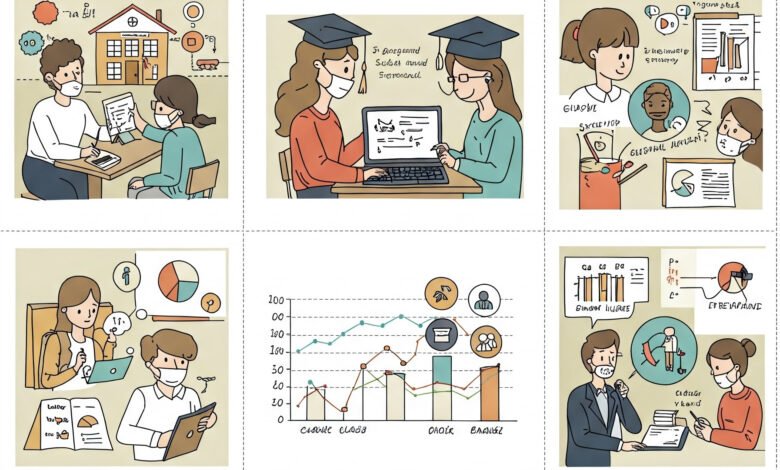The Role of Education in Social Mobility: A Sociological Investigation

Introduction to Social Mobility
Social mobility refers to the movement of individuals or groups within a social hierarchy, which can occur between different socio-economic strata. This concept is crucial in understanding the dynamics of society, as it reflects the opportunities available for individuals to improve their socioeconomic status. Social mobility is indicative of a fair and equitable society, where individuals have the ability to ascend from a position of lower socio-economic status to a higher one based on merit, effort, and opportunity. The presence of high social mobility often signifies a society that promotes equality, access to resources, and individual agency.
Social mobility can manifest in various forms, primarily categorized into intergenerational and intragenerational mobility. Intergenerational mobility involves the changes in social status that occur from one generation to another. For example, children may experience different educational and occupational outcomes compared to their parents, leading to shifts in their social position. Intrigenerational mobility, on the other hand, refers to changes that occur within an individual’s lifetime. An individual may start at a low level of income or social standing and achieve a higher position through career advancements, education, or entrepreneurship.
The significance of social mobility in societal structure cannot be overstated. High levels of mobility contribute to a sense of fairness and meritocracy, encouraging individuals to invest in their personal development and aspirations. It directly influences life outcomes, including economic stability, health, and overall well-being. Education emerges as a pivotal factor in influencing social mobility, as it serves as a primary vehicle for individuals to gain the skills, knowledge, and qualifications necessary to navigate and succeed in the competitive job market. By examining the intersection of education and social mobility, it becomes evident how essential educational opportunities are in determining the pathways individuals can take toward improving their social standing.
Historical Perspectives on Education and Social Mobility
The evolution of education as a significant factor in social mobility can be traced back through various historical epochs, each marked by distinct educational paradigms and critical movements. The emergence of public education in the 19th century, for instance, marked a paradigm shift in societal structures, laying the groundwork for equitable access to education. Reformers such as Horace Mann in the United States championed free public education, believing it would serve as a great equalizer, enabling individuals from disadvantaged backgrounds to improve their socio-economic status.
Throughout history, various movements have aimed to transform educational access and quality, particularly as a means to mitigate social inequalities. The Progressive Era in the early 20th century brought about significant educational reforms, emphasizing the need for experiential learning and critical thinking as opposed to rote memorization. This shift was predicated on the belief that a more engaged and informed citizenry would foster social mobility, thus empowering individuals from diverse socio-economic backgrounds to ascend the social ladder.
Moreover, the Civil Rights Movement of the 1960s underscored the intersection of education and social justice. The landmark case Brown v. Board of Education emphasized that segregated schools were inherently unequal, thereby institutionalizing the idea that education must be a vehicle for social equity. This period saw the introduction of federal programs aimed at enhancing educational opportunities for marginalized communities, further solidifying education’s role in fostering social mobility.
Policies such as Title IX and affirmative action programs aimed not only to eradicate discrimination but also to boost representation from historically underprivileged groups within educational institutions. These reforms collectively illustrate how education has been historically utilized as a tool for challenging social stratification, reinforcing its critical role in advancing social mobility. Understanding these historical paradigms is fundamental for contextualizing current discussions on the efficacy of educational systems in promoting equality and opportunities for all.
Theoretical Frameworks Linking Education and Social Mobility
The relationship between education and social mobility is a multifaceted issue that can be better understood through several sociological theories. These frameworks provide insights into how education serves as a conduit for social advancement, shaping individual opportunities based on socioeconomic factors. Among the most significant theories are human capital theory, social capital theory, and cultural capital theory.
Human capital theory posits that education enhances an individual’s skill set, making them more competitive in the labor market. This theory suggests that investments in education yield returns in the form of higher income and improved employment prospects, thereby facilitating upward mobility. By acquiring knowledge and skills, individuals can increase their human capital, which is often viewed as a key driver of economic success. However, this theory has been critiqued for its focus on individual agency, potentially overlooking structural barriers that may inhibit access to quality education.
Social capital theory shifts the focus to the networks and relationships that individuals cultivate through educational experiences. This theory emphasizes that connections gained in educational settings can lead to job opportunities, mentorship, and access to information that may not be available to those outside these networks. Thus, education not only equips individuals with skills but also provides essential social ties that can bolster their prospects for mobility.
Cultural capital theory further extends this investigation by examining the cultural competencies and knowledge that different social groups possess. This theory, introduced by Pierre Bourdieu, argues that individuals from higher socioeconomic backgrounds often navigate the educational system more effectively due to their familiarity with the norms and expectations of schools and universities. Consequently, cultural capital can influence educational success and, by extension, social mobility.
These theoretical frameworks together illustrate the complex interrelationship between education and social mobility and underline the importance of both individual attributes and societal structures in determining educational outcomes and opportunities.”
The Role of Educational Attainment in Employment Opportunities
Educational attainment plays a significant role in shaping employment opportunities and subsequently influencing income levels within society. Numerous studies have consistently shown a positive correlation between higher educational qualifications and increased probability of securing employment. For instance, individuals with a bachelor’s degree tend to experience lower unemployment rates compared to those without higher education. According to data published by the U.S. Bureau of Labor Statistics, the unemployment rate for individuals with a bachelor’s degree was 2.5% in 2023, compared to 6.0% for those with only a high school diploma. This stark contrast emphasizes the advantage that educational qualifications afford in the job market.
Furthermore, the economic benefits of education extend beyond mere employment rates. Research indicates that higher educational attainment is associated with significantly higher income levels. For example, individuals with a bachelor’s degree earn approximately 66% more than those with only a high school diploma over their lifetime, as outlined in various sociological studies. This wage differential underscores how education not only serves as a catalyst for employment but also as a critical determinant of economic prosperity.
Despite these clear correlations, it is essential to acknowledge the barriers that impede certain groups from attaining higher education. Systemic issues, such as socioeconomic disparities, limited access to quality educational resources, and discrimination, continue to hinder social mobility for marginalized populations. Consequently, the disparities in educational attainment can perpetuate cycles of poverty, limiting the ability of these populations to access better job opportunities.
Overall, while educational attainment significantly enhances employment prospects and income levels, societal barriers must be addressed to ensure equitable access to education for all individuals. By doing so, we can foster a more inclusive environment where social mobility can be achieved through the transformative power of education.
Educational Inequalities and Their Impact on Social Mobility
Educational inequalities represent significant barriers that impact social mobility, affecting individuals from marginalized groups disproportionately. Disparities in the educational system manifest in various forms, rooted in factors such as race, socioeconomic status, geographic location, and gender. These inequalities not only hinder access to quality education but also dictate the success that students can achieve within the educational landscape.
Racial disparities in education are particularly pronounced, with students of color often encountering systemic obstacles that impede their educational achievements. Schools in predominantly minority neighborhoods frequently receive less funding, leading to insufficient resources, overcrowded classrooms, and outdated materials. This inequitable distribution of resources reinforces a cycle of disadvantage that restricts opportunities for higher education and professional advancement among these communities.
Socioeconomic status is another critical determinant of educational access and success. Students from lower-income families may face challenges such as food insecurity, lack of access to reliable transportation, and a limited ability to afford extracurricular enrichment opportunities. These factors contribute to lower academic performance and higher dropout rates, further perpetuating social immobility. Geographic location plays a similar role, as rural or underfunded urban schools often lack the same quality of education and support services available in more affluent areas. This geographical divide exacerbates the educational gap, influencing long-term socioeconomic outcomes for students.
Gender disparities also exist within the educational framework, where certain groups, particularly girls in specific cultures, may be discouraged from pursuing education due to traditional norms. This gender bias can significantly impact their future prospects, limiting their ability to enter higher education or differentiate in the job marketplace. Overall, these interlinked inequalities create a complex landscape where access to quality education serves as both a predictor and a determinant of social mobility, deeply entrenching cycles of privilege and disadvantage across generations. Ensuring equitable educational opportunities is thus essential for promoting social mobility.
The Impact of Policy on Education and Social Mobility
Government policies significantly influence the landscape of education, ultimately affecting social mobility across diverse communities. Educational opportunities are often shaped by the priorities and funding decisions made at both the local and national levels. Effective policies can create pathways to advancement, whereas misguided interventions may hinder the prospects of upward mobility.
One notable example of successful educational policy is the implementation of comprehensive early childhood education programs. These initiatives have been shown to provide essential skills and knowledge that equip children from disadvantaged backgrounds to enter primary education on equal footing with their peers. By ensuring access to quality pre-K education, policymakers have effectively reduced educational inequality, laying the groundwork for improved social mobility in the long run.
In contrast, funding cuts in education can exacerbate existing disparities. When schools are underfunded, they often lack the resources needed to provide a quality education, which disproportionately affects students from low-income families. This lack of investment results in fewer extracurricular activities, inadequate teacher support, and diminished access to advanced coursework, all of which are fundamental for fostering an environment conducive to learning and growth.
Additionally, standardized testing and the prevalence of school choice initiatives introduce further complexities into the educational landscape. While theoretically intended to promote competition and enhance educational quality, these policies can inadvertently narrow the definitions of success and opportunity. Standardized tests often fail to account for the diverse backgrounds of students, leading to a system that may disadvantage those with fewer resources. Similarly, school choice programs, although beneficial for some, can lead to increased segregation and inequity within educational systems, impacting social mobility for marginalized students.
Ultimately, it is evident that policy decisions related to education play a pivotal role in shaping social mobility outcomes. By understanding these impacts, stakeholders can better advocate for reforms that promote equitable educational opportunities for all students, regardless of their socioeconomic status.
Case Studies of Successful Educational Initiatives
Educational interventions aimed at improving access and outcomes for disadvantaged populations play a critical role in fostering social mobility. Several successful initiatives worldwide illustrate how targeted educational programs can facilitate this vital process. One exemplary case is the “Educate Girls” program in India, which focuses on increasing enrollment and retention of girls in schools. By mobilizing communities, offering financial incentives, and providing vocational training, this initiative has led to significant improvements in educational attainment among girls in rural areas, ultimately contributing to their enhanced socio-economic status.
Another noteworthy initiative is the “P-TECH” model that originated in the United States. This program connects high schools, community colleges, and industry partners to provide students with a curriculum that combines academic and technical education. By enabling students to earn a high school diploma along with a post-secondary degree, P-TECH allows participants to gain critical skills and job offers directly from the businesses involved. The success of this program has been demonstrated through improved graduation rates and career placements, making it a compelling example of how integrated educational systems can support social mobility for first-generation college students.
In the realm of vocational training, Germany’s dual education system is widely recognized as a benchmark. This system emphasizes practical training within a workplace alongside formal education, enabling students to acquire hands-on experience while learning theory. The successful integration of local businesses in this initiative ensures that students are better prepared for employment, thereby enhancing their economic prospects and promoting social mobility. Each of these case studies provides valuable insights into effective strategies that improve educational access and outcomes, demonstrating the tangible impact that well-designed educational initiatives can have on disadvantaged populations.
Future Trends in Education and Social Mobility
The landscape of education is currently undergoing significant transformation, shaped by technological advancements, globalization, and the evolving job market. As we look to the future, the role of education in promoting social mobility remains pivotal, albeit with emerging challenges and opportunities that warrant careful consideration. The integration of technology in education, including online learning platforms and artificial intelligence, is revolutionizing traditional teaching methodologies. These innovations can enhance accessibility and individualized learning experiences, potentially breaking down barriers for disadvantaged communities. However, reliance on technology also raises concerns about the digital divide, which could exacerbate existing inequalities in social mobility.
Globalization further complicates the relationship between education and social mobility. The interconnectedness of economies means that job markets are becoming increasingly competitive and diverse. Skills that were once locally relevant are now being overshadowed by a demand for global competencies. As a result, educational institutions must adapt to train individuals not only in academic subjects but also in cross-cultural communication and technological proficiency. While globalization presents avenues for students to access new career opportunities, it simultaneously increases the stakes for those lacking the requisite skills, risking widening social disparities.
Furthermore, the future of education must address the dynamic needs of a rapidly changing job market. As occupations evolve, continuous education and upskilling will become critical for sustained social mobility. Lifelong learning initiatives may be necessary to ensure individuals can adapt to changing employment landscapes and seize opportunities for advancement. In consideration of these shifting paradigms, it becomes imperative to foster an education system that is both inclusive and adaptive, addressing the diverse needs of the population. By proactively engaging with these trends, the potential for education as a vehicle for social mobility may still flourish in the coming years.
Conclusion: Reaffirming the Importance of Education for Social Mobility
Throughout this investigation, it has become increasingly clear that education plays a critical role in facilitating social mobility. The findings underscore that access to quality education significantly influences an individual’s ability to rise above their socio-economic circumstances. By providing essential knowledge, skills, and networks, education acts as a stepping stone that enables individuals to improve their social status and economic prospects.
Moreover, the disparities in educational access and quality across different socio-economic groups highlight a pressing need for reform within the education system. It is essential to ensure that educational opportunities are equitable and accessible to all individuals, regardless of their background. This calls for targeted policies and investments aimed at improving the quality of education in underserved communities, thereby empowering marginalized groups and contributing to a more inclusive society.
Furthermore, the discussions surrounding the transformative power of education reveal that it is not just a personal benefit but a societal imperative. A well-educated populace contributes to economic growth, decreases dependency on social welfare, and fosters civic engagement, which collectively enhances the fabric of society. In recognizing education as a vital instrument for social mobility, stakeholders must collaborate to create an environment that nurtures talent and fosters potential, particularly among those who have been historically disadvantaged.
In conclusion, the evidence suggests that continuing to prioritize education is essential for cultivating social mobility. As we move forward, it is imperative that we collectively advocate for sustained investments and reforms in the educational sector, ensuring that education remains a pathway available to all individuals. Only through a concerted effort to enhance educational access and quality can we hope to create a more equitable society that uplifts everyone, regardless of their starting point in life.






















